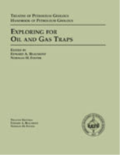Pore system shapes
Revision as of 13:53, 4 April 2022 by Cwhitehurst (talk | contribs) (added Category:Treatise Handbook 3 using HotCat)
| It has been suggested that this article be merged with [[::Pore systems|Pore systems]]. (Discuss) |
| Exploring for Oil and Gas Traps | |

| |
| Series | Treatise in Petroleum Geology |
|---|---|
| Part | Predicting the occurrence of oil and gas traps |
| Chapter | Predicting reservoir system quality and performance |
| Author | Dan J. Hartmann, Edward A. Beaumont |
| Link | Web page |
| Store | AAPG Store |
Archie and non-Archie rocks
Choquette and Pray's[1] porosity types include two different groups of pore system shapes: petrophysically simple Archie porosity and petrophysically complex non-Archie porosity. In most cases, water saturation (Sw) of rocks with Archie porosity can be predicted from log analysis using the Archie equation
where:
- Sw = water saturation of the uninvaded zone
- n = saturation exponent, which varies from 1.8 to 4.0 but normally is 2.0
- Rw = formation water resistivity at formation temperature
- Φ = porosity
- m = cementation exponent, which varies from 1.7 to 3.0 but normally is 2.0
- Rt = true resistivity of the formation, corrected for invasion, borehole, thin bed, and other effects
without modification. To predict water saturation in rocks with non-Archie porosity, we modify the Archie equation.
Table of characteristics
The table below describes pore system shapes and other important characteristics of Archie and non-Archie rocks.[2]
| Feature | Archie | Non-Archie |
|---|---|---|
| Pore system shapes | Intergranular (found between rounded particles); interparticle | Mold-like |
| Intercrystalline (found between angular particles) | Vug-like | |
| Fracture-like | ||
| Relationship of pore shape to rock particles | Negative image of particles making up matrix | Relates only indirectly to particles making up matrix |
| Pore connectivity | Pore throats connect pores into regular networks | Pores are irregularly distributed and can be either poorly or very well connected |
| Porosity reduction processes | Grain coating or pore filling by calcite, silica, or dolomite | Pore or pore throat filling by clays or other minerals |
See also
- Pore system fundamentals
- Pore and pore throat sizes
- Pore throat size and connectivity
- Pore systems
- Capillary pressure (Pc) curves: pore throat size determination
References
- ↑ Choquette, P. W., and L. C. Pray, 1970, Geologic nomenclature and classification of porosity in sedimentary carbonates: AAPG Bulletin, vol. 54, no. 2, p. 207–250. Classic reference for basic concepts regarding carbonate porosity.
- ↑ Coalson, E. B., S. M. Goolsby, and M. H. Franklin, 1994, Subtle seals and fluid-flow barriers in carbonate rocks, in J. C. Dolson, M. L. Hendricks, and W. A. Wescott, eds., Unconformity Related Hydrocarbons in Sedimentary Sequences: RMAG Guidebook for Petroleum Exploration and Exploitation in Clastic and Carbonate Sediments, p. 45–58.
